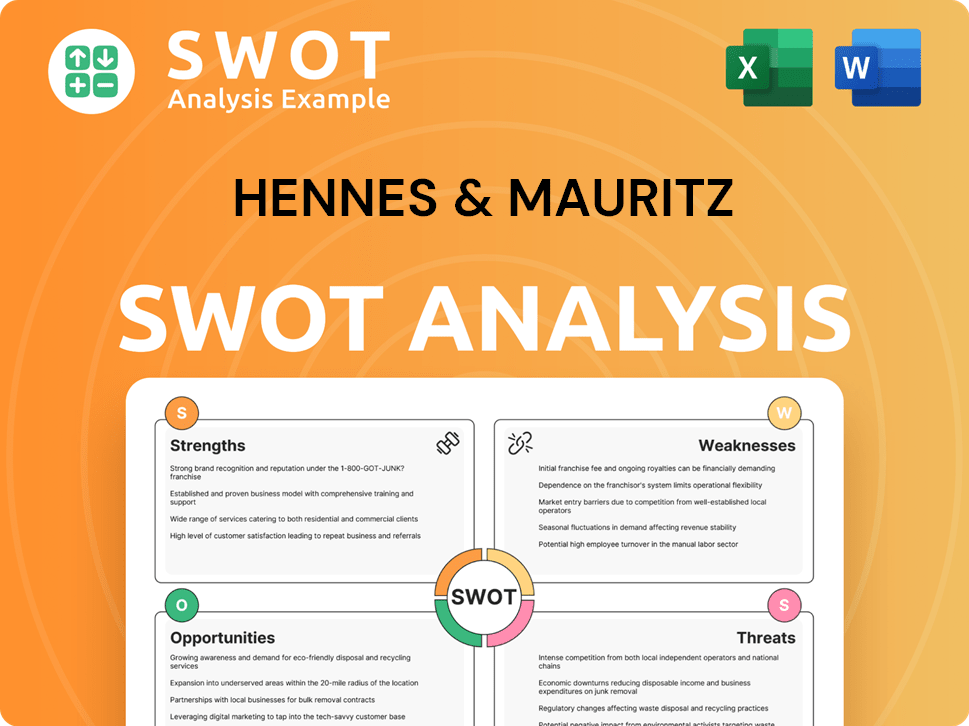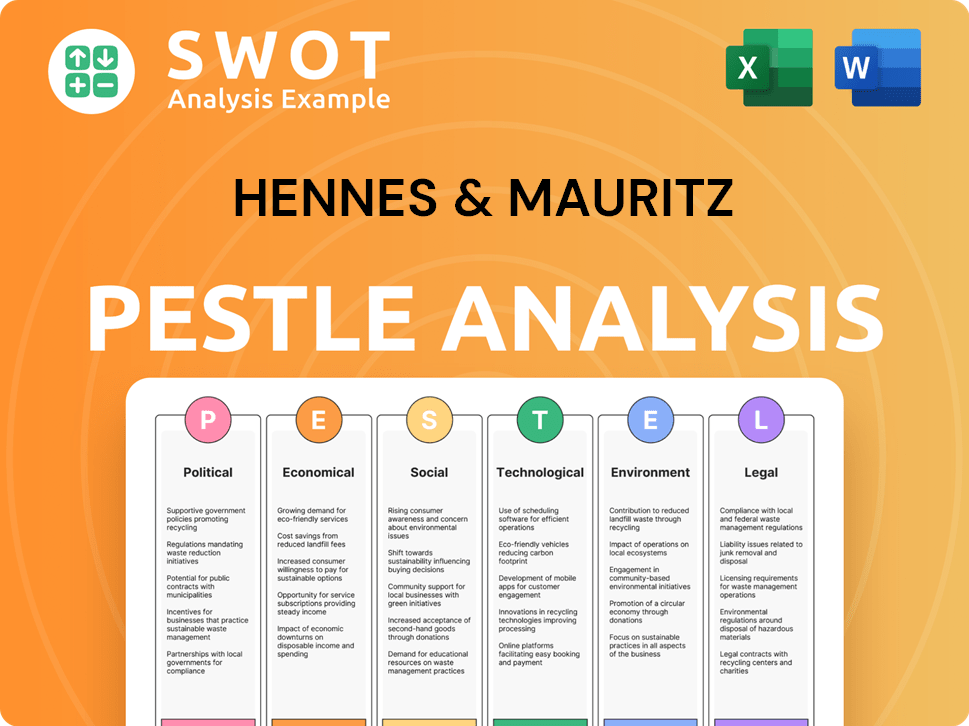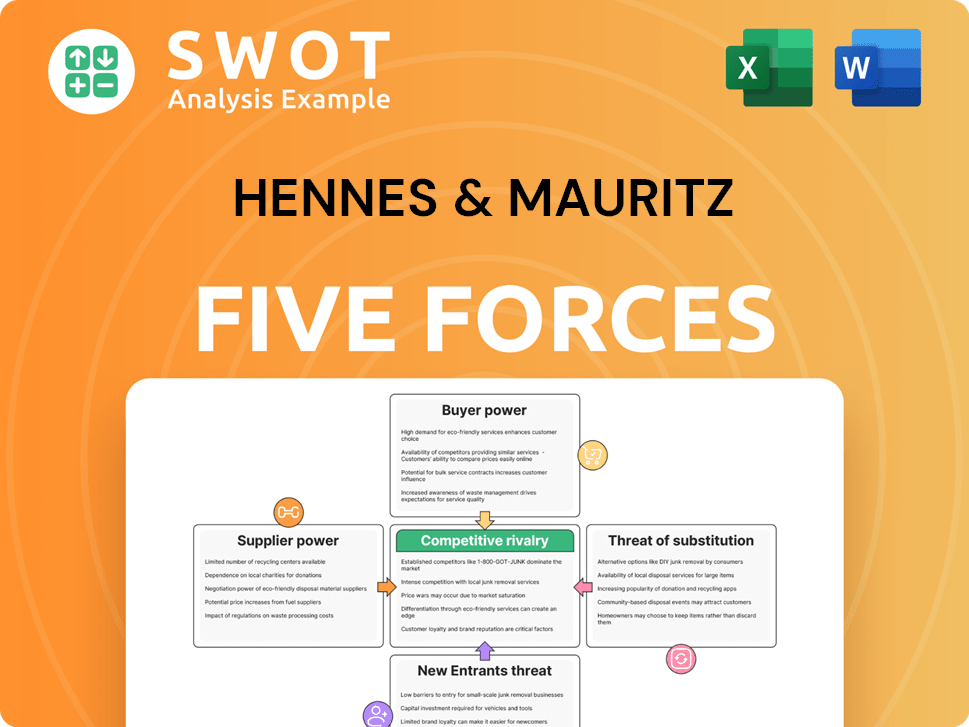Hennes & Mauritz Bundle
How Does H&M Stack Up in the Cutthroat Fashion World?
The fashion industry is a whirlwind of trends, and staying ahead requires more than just stylish clothes. Understanding the Hennes & Mauritz SWOT Analysis is crucial to navigating this dynamic environment. This article dives into the competitive landscape of Hennes & Mauritz (H&M), a global leader in fast fashion.

The fast fashion rivals constantly battle for market share, and H&M's success hinges on its ability to adapt. This in-depth H&M market analysis will identify its main competitors, explore its competitive advantages, and examine the broader industry trends that shape its future. We'll dissect how H&M competes in fast fashion, analyzing its pricing strategy and international expansion.
Where Does Hennes & Mauritz’ Stand in the Current Market?
H&M holds a prominent position in the global fashion retail market. The company is consistently ranked among the top players. H&M's core operations revolve around designing, producing, and retailing clothing, accessories, and home goods, catering to a broad consumer base.
H&M's value proposition centers on providing 'fashion and quality at the best price'. This approach is supported by a vast network of physical stores and a growing e-commerce platform. The company's geographic presence is extensive, spanning across Europe, North America, Asia, Africa, and South America.
H&M, along with Inditex (Zara's parent company), generally dominates the fast-fashion segment. While specific market share figures fluctuate, H&M remains a key player in the retail clothing brands arena. The company competes within a dynamic fashion industry competition landscape.
In the first quarter of 2024, H&M reported net sales of SEK 53,697 million. Its operating profit reached SEK 2,077 million during the same period, indicating a healthy financial standing. This financial performance is crucial for understanding H&M's competitive advantages.
H&M maintains a strong presence in its established European markets. The company continues to expand and strengthen its position in emerging markets. Its international expansion strategy and competition are key aspects of its market position.
H&M is focusing on digital transformation and sustainability. This includes garment collection programs and the use of more sustainable materials. These initiatives are vital for appealing to environmentally conscious consumers.
The Marketing Strategy of Hennes & Mauritz demonstrates the company's approach to maintain its market position. H&M's competitive landscape includes fast fashion rivals. The company's ability to adapt to changing consumer preferences and market trends is crucial.
- H&M's main competitors 2024 include Inditex (Zara), as well as other global and regional brands.
- The impact of fast fashion on H&M's competition is significant, requiring continuous innovation in design and supply chain management.
- Sustainability initiatives of H&M competitors are becoming increasingly important, influencing consumer choices and brand strategies.
- H&M's online retail competition is growing, necessitating strong e-commerce capabilities and digital marketing strategies.
Hennes & Mauritz SWOT Analysis
- Complete SWOT Breakdown
- Fully Customizable
- Editable in Excel & Word
- Professional Formatting
- Investor-Ready Format

Who Are the Main Competitors Challenging Hennes & Mauritz?
The Owners & Shareholders of Hennes & Mauritz face a dynamic and multifaceted competitive landscape. The fashion retail market is fiercely contested, with numerous players vying for consumer attention and market share. This environment demands constant adaptation and innovation to stay ahead.
Understanding the Hennes & Mauritz competitive landscape is crucial for evaluating its strategic positioning and future prospects. Key rivals employ diverse strategies, from rapid trend adaptation to aggressive pricing, creating a complex challenge for H&M. Market analysis reveals that the company must navigate these competitive pressures effectively to maintain its position.
The fast fashion industry is characterized by intense competition, with companies constantly striving to offer the latest trends at competitive prices. This drives a need for efficient supply chains, effective marketing, and a strong understanding of consumer preferences. The competitive advantages of H&M are continually tested by the actions of its rivals.
H&M's primary direct competitor is Inditex, the parent company of Zara. Zara's fast-fashion model and agile supply chain allow it to quickly respond to market trends. The speed to market is a key battleground.
UNIQLO (Fast Retailing) is a major direct competitor, known for its focus on high-quality basics and innovative materials. Primark (Associated British Foods) competes aggressively on price. Shein, an online-only fast-fashion retailer, has emerged as a disruptive force.
Indirect competition comes from department stores with private labels, luxury brands with diffusion lines, and online fashion platforms. Resale platforms and sustainable fashion brands also indirectly challenge H&M.
H&M and Zara constantly vie for market share in key regions through marketing campaigns and strategic store openings or closures. The competitive landscape is shaped by organic growth and direct competition.
Emerging players leveraging AI and data analytics for trend forecasting and production are disrupting traditional models. This forces H&M to continuously innovate and adapt to stay competitive.
H&M's competitive strategies include focusing on fast fashion, sustainability, and online retail. The company's ability to manage its supply chain and respond to consumer demand is critical.
In 2024, H&M's main competitors, including Zara and UNIQLO, continue to challenge its market position. H&M's market share analysis reveals the impact of these rivals. The company's SWOT analysis highlights its strengths, weaknesses, opportunities, and threats within the fashion industry. The impact of fast fashion on H&M's competition is significant, with rapid changes in consumer preferences and trends. H&M's pricing strategy is often compared to its competitors, such as Zara and Primark. H&M's supply chain is a key factor in its ability to compete effectively. The company's international expansion strategy is also influenced by the competitive landscape.
- Zara: Known for its rapid response to trends and efficient supply chain. In 2024, Zara's revenue reached approximately $30 billion, reflecting its strong market position.
- UNIQLO: Focuses on high-quality basics and innovative materials. UNIQLO's global sales in 2024 were around $20 billion, demonstrating its appeal to a broad consumer base.
- Primark: Competes aggressively on price. Primark's revenue in 2024 was approximately $10 billion, driven by its value-oriented strategy.
- Shein: An online-only fast-fashion retailer that has gained significant traction, especially among younger consumers. Shein's valuation in 2024 exceeded $60 billion, indicating its disruptive influence.
Hennes & Mauritz PESTLE Analysis
- Covers All 6 PESTLE Categories
- No Research Needed – Save Hours of Work
- Built by Experts, Trusted by Consultants
- Instant Download, Ready to Use
- 100% Editable, Fully Customizable

What Gives Hennes & Mauritz a Competitive Edge Over Its Rivals?
Understanding the Hennes & Mauritz competitive landscape involves recognizing its core strengths and how it maintains its position in the global fashion retail market. The company, often referred to as H&M, has built a strong brand equity over decades, offering trendy and affordable fashion. This has fostered significant customer loyalty, which is a key factor in the fashion industry competition. The company's ability to adapt quickly to fashion trends and translate them into marketable collections is a crucial advantage, supported by its design teams and supply chain.
H&M's competitive advantages are multifaceted, allowing it to maintain a strong position in the global fashion retail market. One of the primary strengths is its powerful brand equity, built over decades of offering trendy and affordable fashion. This strong brand recognition fosters significant customer loyalty, with consumers associating H&M with value and up-to-date styles. The company benefits from substantial economies of scale, allowing it to negotiate favorable terms with suppliers and achieve cost efficiencies in production and distribution due to its massive volume of operations.
The company's extensive global distribution network, comprising thousands of physical stores across numerous countries and a robust e-commerce platform, provides broad accessibility to its customer base. Furthermore, H&M has made significant strides in integrating sustainability into its business model, a growing concern for consumers. Its commitment to sustainable practices, including initiatives for circularity and the use of more sustainable materials, differentiates it from some competitors and appeals to an increasingly eco-conscious demographic. To delve deeper into the company's strategic direction, explore the Growth Strategy of Hennes & Mauritz.
H&M's strong brand equity, built over years of offering trendy and affordable fashion, fosters significant customer loyalty. Consumers associate H&M with value and up-to-date styles. This brand recognition is a key factor in maintaining its market position amidst H&M competitors.
The company benefits from substantial economies of scale, enabling it to negotiate favorable terms with suppliers. This allows H&M to achieve cost efficiencies in production and distribution, offering competitive pricing. Competitive pricing is a key differentiator in the fast-fashion segment, impacting H&M market analysis.
H&M boasts an extensive global distribution network, including thousands of physical stores and a robust e-commerce platform. This omni-channel presence provides broad accessibility to its customer base. This reach is crucial in the competitive landscape of retail clothing brands.
H&M has made significant strides in integrating sustainability into its business model, appealing to eco-conscious consumers. Its commitment to sustainable practices, including initiatives for circularity and the use of more sustainable materials, differentiates it from some competitors. This is a growing trend among fast fashion rivals.
H&M's competitive advantages include strong brand recognition, economies of scale, a global distribution network, and sustainability initiatives. These factors contribute to its strong market position in the fast-fashion industry. The company's ability to quickly adapt to fashion trends remains a crucial advantage.
- Brand Recognition: Strong brand equity and customer loyalty.
- Economies of Scale: Favorable supplier terms and cost efficiencies.
- Global Reach: Extensive physical and online presence.
- Sustainability: Commitment to eco-friendly practices.
Hennes & Mauritz Business Model Canvas
- Complete 9-Block Business Model Canvas
- Effortlessly Communicate Your Business Strategy
- Investor-Ready BMC Format
- 100% Editable and Customizable
- Clear and Structured Layout

What Industry Trends Are Reshaping Hennes & Mauritz’s Competitive Landscape?
The fashion retail industry's competitive landscape is currently undergoing significant transformations, impacting companies like Hennes & Mauritz. The rise of digital platforms, changing consumer preferences, and increased focus on sustainability are reshaping the strategies and market positions of major players. Understanding these shifts is crucial for evaluating H&M's future outlook and its ability to navigate the evolving challenges and opportunities.
H&M faces both risks and opportunities in this dynamic environment. Increased competition from fast fashion rivals and the growing importance of sustainability pose challenges. However, H&M can leverage technological advancements, sustainability initiatives, and emerging market opportunities to strengthen its market position. A deeper dive into the H&M market analysis reveals how these factors are influencing its strategic decisions.
Several trends are currently shaping the fashion retail sector. These include the integration of AI and data analytics for trend forecasting and inventory management, increased regulatory focus on environmental and labor practices, and evolving consumer preferences towards sustainability and personalized experiences. The industry is also seeing a shift towards more digital and omnichannel retail models.
H&M faces several challenges. These include the rapid growth of ultra-fast fashion brands like Shein, increased regulatory pressures related to sustainability, and potential impacts from economic slowdowns in key markets. Adapting to these challenges requires strategic investments in technology, supply chain optimization, and sustainable practices. Understanding the H&M competitors is key to addressing these challenges.
There are also numerous opportunities for H&M. These include leveraging technology to enhance e-commerce and customer experiences, attracting environmentally conscious consumers through sustainability initiatives, and expanding into emerging markets. Strategic partnerships and diversification of brand offerings can also provide new growth avenues. The company's ability to capitalize on these opportunities will be critical.
To remain competitive, H&M is deploying several strategies. These include continued investment in technology, strengthening sustainability initiatives, optimizing its store portfolio, and diversifying its brand offerings to cater to a wider range of consumer segments. These initiatives are designed to ensure long-term resilience and growth. To learn more about the company's history, check out the Brief History of Hennes & Mauritz.
H&M's strategic responses involve several key areas. The company is focusing on digital transformation, enhancing its sustainability efforts, optimizing its store network, and diversifying its brand portfolio. These strategies aim to strengthen its market position and adapt to changing consumer demands. The Hennes & Mauritz competitive landscape is driving these strategic shifts.
- Digital Transformation: Investing heavily in e-commerce platforms, AI-driven analytics, and supply chain optimization to improve efficiency and customer experience.
- Sustainability Initiatives: Expanding the use of sustainable materials, implementing circular business models, and enhancing transparency across the supply chain.
- Store Optimization: Reviewing and adjusting its store portfolio, including closing underperforming stores and investing in store renovations to enhance the in-store experience.
- Brand Diversification: Expanding its brand portfolio to cater to diverse consumer segments and preferences, including value-focused and premium offerings.
Hennes & Mauritz Porter's Five Forces Analysis
- Covers All 5 Competitive Forces in Detail
- Structured for Consultants, Students, and Founders
- 100% Editable in Microsoft Word & Excel
- Instant Digital Download – Use Immediately
- Compatible with Mac & PC – Fully Unlocked

Related Blogs
- What are Mission Vision & Core Values of Hennes & Mauritz Company?
- What is Growth Strategy and Future Prospects of Hennes & Mauritz Company?
- How Does Hennes & Mauritz Company Work?
- What is Sales and Marketing Strategy of Hennes & Mauritz Company?
- What is Brief History of Hennes & Mauritz Company?
- Who Owns Hennes & Mauritz Company?
- What is Customer Demographics and Target Market of Hennes & Mauritz Company?
Disclaimer
All information, articles, and product details provided on this website are for general informational and educational purposes only. We do not claim any ownership over, nor do we intend to infringe upon, any trademarks, copyrights, logos, brand names, or other intellectual property mentioned or depicted on this site. Such intellectual property remains the property of its respective owners, and any references here are made solely for identification or informational purposes, without implying any affiliation, endorsement, or partnership.
We make no representations or warranties, express or implied, regarding the accuracy, completeness, or suitability of any content or products presented. Nothing on this website should be construed as legal, tax, investment, financial, medical, or other professional advice. In addition, no part of this site—including articles or product references—constitutes a solicitation, recommendation, endorsement, advertisement, or offer to buy or sell any securities, franchises, or other financial instruments, particularly in jurisdictions where such activity would be unlawful.
All content is of a general nature and may not address the specific circumstances of any individual or entity. It is not a substitute for professional advice or services. Any actions you take based on the information provided here are strictly at your own risk. You accept full responsibility for any decisions or outcomes arising from your use of this website and agree to release us from any liability in connection with your use of, or reliance upon, the content or products found herein.